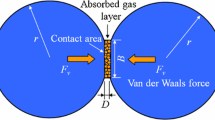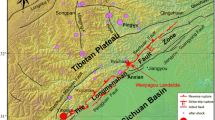Abstract
In order to provide a comprehensive comparison between two current numerical methods employed in the modelling of rock avalanches, the discrete element method (DEM) and the material point method (MPM) were used to simulate the mass propagation along a \(45^{\circ }\) plane transitioning to a horizontal plane. For the DEM simulations, an in-house 3D code whose particles can be modelled as tetrahedral elements was used. Additionally, the flow was canalised using frictionless walls. For the MPM simulations, a 2D code was also developed and employed to run plane strain simulations. Comparisons were made in terms of runout distance, spreading and energy dissipated. Influence of parameters such as initial sample geometry, basal friction coefficient and shape of blocks composing the sample was studied. We found that there are proper correlations between the two methods when the basal friction coefficient has a low value, or when the rolling of the blocks is hindered by using elongated shapes for the blocks. These correlations become less satisfactory as the basal friction coefficient is increased, due to the oversimplified constitutive law employed in MPM.























Similar content being viewed by others
References
Banton J, Villard P, Jongmans D, Scavia C (2009) Two-dimensional discrete element models of debris avalanches: parameterization and the reproducibility of experimental results. J Geophys Res 114(F4):F04013. https://doi.org/10.1029/2008JF001161
Bardenhagen SG, Kober EM (2004) The generalized interpolation material point method. CMES Comput Model Eng Sci 5(6):477–495. https://doi.org/10.3970/cmes.2004.005.477
Belytschko T, Lu YY, Gu L (1994) Element-free Galerkin methods. Int J Numer Methods Eng 37(2):229–256. https://doi.org/10.1002/nme.1620370205
Bottelin P, Jongmans D, Daudon D, Mathy A, Helmstetter A, Bonilla-Sierra V, Cadet H, Amitrano D, Richefeu V, Lorier L, Baillet L, Villard P, Donz F (2014) Seismic and mechanical studies of the artificially triggered rockfall at the mount neron (french alps, december 2011). Nat Hazards Earth Syst Sci 14(2):3175–3193
Brackbill J, Ruppel H (1986) FLIP: a method for adaptively zoned, particle-in-cell calculations of fluid flows in two dimensions. J Comput Phys 65(2):314–343. https://doi.org/10.1016/0021-9991(86)90211-1
Brackbill JU, Kothe DB, Ruppel HM (1988) Flip: a low-dissipation, particle-in-cell method for fluid flow. Comput Phys Commun 48(1):25–38. https://doi.org/10.1016/0010-4655(88)90020-3
Brannon R, Burghardt JA, Bronowski D, Bauer S (2009) Experimental assessment of unvalidated assumptions in classical plasticity theory, Report No.: SAND2009-0351, Grant Number: AC04-94AL85000, Sandia National Laboratories (Pub.). https://doi.org/10.2172/948711
Cleary PW, Prakash M (2004) Discrete-element modelling and smoothed particle hydrodynamics: potential in the environmental sciences. Philos Trans R Soc A Math Phys Eng Sci 362(1822):2003–2030. https://doi.org/10.1098/rsta.2004.1428
Cundall P (1971) A computer model for simulating progressive, large scale movement in blocky rock systems. In: Proceedings of the symposium of the international society for rock mechanics, society for rock mechanics (ISRM), Nancy, France, vol 2, pp 129–136
Cundall PA, Strack ODL (1979) A discrete numerical model for granular assemblies. Géotechnique 29(1):47–65. https://doi.org/10.1680/geot.1979.29.1.47
Gingold RA, Monaghan JJ (1977) Smoothed particle hydrodynamics: theory and application to non-spherical stars. Mon Not R Astron Soc 181(3):375–389. https://doi.org/10.1093/mnras/181.3.375
Harlow FH (1957) Hydrodynamic problems involving large fluid distortions. J ACM 4(2):137–142. https://doi.org/10.1145/320868.320871
Jop P, Forterre Y, Pouliquen O (2006) A new constitutive law for dense granular flows. Nature 441:1–13
Mangeney-Castelnau A (2003) Numerical modeling of avalanches based on Saint Venant equations using a kinetic scheme. J Geophys Res 108(B11):2527. https://doi.org/10.1029/2002JB002024
Manzella I, Labiouse V (2009) Flow experiments with gravel and blocks at small scale to investigate parameters and mechanisms involved in rock avalanches. Eng Geol 109(1–2):146–158. https://doi.org/10.1016/j.enggeo.2008.11.006
Manzella I, Labiouse V (2013) Empirical and analytical analyses of laboratory granular flows to investigate rock avalanche propagation. Landslides 10(1):23–36. https://doi.org/10.1007/s10346-011-0313-5
McDougall S, Hungr O (2004) A model for the analysis of rapid landslide motion across three-dimensional terrain. Can Geotech J 41(6):1084–1097. https://doi.org/10.1139/t04-052
Mollon G, Richefeu V, Villard P, Daudon D (2012) Numerical simulation of rock avalanches: influence of a local dissipative contact model on the collective behavior of granular flows. J Geophys Res Earth 117(F2):F02036. https://doi.org/10.1029/2011JF002202
Mollon G, Richefeu V, Villard P, Daudon D (2015) Discrete modelling of rock avalanches: sensitivity to block and slope geometries. Granul Matter 17(5):645–666. https://doi.org/10.1007/s10035-015-0586-9
Moresi L, Dufour F, Mühlhaus HB (2003) A Lagrangian integration point finite element method for large deformation modeling of viscoelastic geomaterials. J Comput Phys 184:476–497. https://doi.org/10.1016/S0021-9991(02)00031-1
Okura Y, Kitahara H, Sammori T, Kawanami A (2000) Effects of rockfall volume on runout distance. Eng Geol 58(2):109–124. https://doi.org/10.1016/S0013-7952(00)00049-1
Pirulli M, Bristeau MO, Mangeney A, Scavia C (2007) The effect of the earth pressure coefficients on the runout of granular material. Environ Model Softw 22(10):1437–1454. https://doi.org/10.1016/j.envsoft.2006.06.006
Richefeu V, Mollon G, Daudon D, Villard P (2012) Dissipative contacts and realistic block shapes for modeling rock avalanches. Eng Geol 149–150:78–92. https://doi.org/10.1016/j.enggeo.2012.07.021
Stoker H (1999) Developments of the arbitrary lagrangian-eulerian method in non-linear solid mechanics applications to forming processes. Universiteit Twente, Enschede
Sulsky D, Brackbill JU (1991) A numerical method for suspension flow. J Comput Phys 96(2):339–368. https://doi.org/10.1016/0021-9991(91)90240-L
Sulsky D, Chen Z, Schreyer HH (1994) A particle method for history-dependent materials. Comput Methods Appl Mech 118:179–196. https://doi.org/10.1016/0045-7825(94)90112-0
Taboada A, Estrada N (2009) Rock-and-soil avalanches: theory and simulation. J Geophys Res Solid Earth 114(3):1–23. https://doi.org/10.1029/2008JF001072
Tommasi P, Campedel P, Consorti C, Ribacchi R (2008) A discontinuous approach to the numerical modelling of rock avalanches. Rock Mech Rock Eng 41(1):37–58. https://doi.org/10.1007/s00603-007-0133-z
Valentino R, Barla G, Montrasio L (2008) Experimental analysis and micromechanical modelling of dry granular flow and impacts in laboratory flume tests. Rock Mech Rock Eng 41(1):153–177. https://doi.org/10.1007/s00603-006-0126-3
Wood DM (1991) Soil behaviour and critical state soil mechanics. Cambridge University Press, Cambridge. https://doi.org/10.1017/CBO9781139878272
Zhou GG, Sun QC (2013) Three-dimensional numerical study on flow regimes of dry granular flows by DEM. Powder Technol 239:115–127. https://doi.org/10.1016/j.powtec.2013.01.057
Zienkiewicz OC, Taylor RLRL (2005) The finite element method for solid and structural mechanics. Elsevier Butterworth-Heinemann, Oxford
Acknowledgements
This work was supported and funded by IMSRN company (headed by Pierre Plotto) and ANRT (French ministry: Ministère de l’Enseignement supérieur, de la Recherche et de l’Innovation).
Author information
Authors and Affiliations
Corresponding author
Additional information
Publisher's Note
Springer Nature remains neutral with regard to jurisdictional claims in published maps and institutional affiliations.
Electronic supplementary material
Below is the link to the electronic supplementary material.
Rights and permissions
About this article
Cite this article
Gracia, F., Villard, P. & Richefeu, V. Comparison of two numerical approaches (DEM and MPM) applied to unsteady flow. Comp. Part. Mech. 6, 591–609 (2019). https://doi.org/10.1007/s40571-019-00236-1
Received:
Revised:
Accepted:
Published:
Issue Date:
DOI: https://doi.org/10.1007/s40571-019-00236-1




